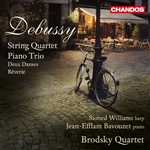CLAUDE DEBUSSY
(1862-1918)
Premier Quatuor, Op. 10 (1893)
26:51
in G minor - in g-Moll - en sol mineur
for strings
1.
I
Animé et très décidé - Un peu retenu - En serrant le mouvement - Premier Mouvement - En animant -
6:30
2.
II
Assez vif et bien rythmé - Même mouvement
3:56
3.
III
Andantino doucement expressif - Un peu plus vite - Premier Mouvement
8:46
4.
IV
Trés modéré - En animant peu à peu - Très mouvementé et avec passion -
7:30
for chromatic harp and string orchestra
Adapted for pedal harp and string quintet by Fabrice Pierre
Chris Laurence double-bass
5.
I
Danse sacrée. Très modéré - Sans lenteur - En animant peu à peu -
5:13
6.
II
Danse profane. Modéré - Animez - Tempo I - Animez - Retenu - A tempo -
5:28
Solo: Sioned Williams harp
Premier Trio (1880)†
21:59
in G major - in G-Dur - en sol majeur
for violin, cello, and piano
Beaucoup de notes accompagnées de beaucoup d'amitié, offert par l'auteur à Son professeur Monsieur Émile Durand
7.
Andantino con moto allegro - Allegro appassionato - Un poco rallentando -
8:21
8.
Scherzo. Intermezzo. Moderato con Allegro - Un poco più lento - Tempo I
3:25
9.
Andante espressivo - Un poco più mosso - Tempo I
4:28
10.
Finale. Appassionato - Un poco ritenuto - [Tempo I]
5:41
Solo: Jean-Efflam Bavouzet piano
11.
Reverie (c. 1890)
5:52
for piano
Arranged for string quartet by Paul Cassidy
Andantino sans lenteur
Chamber: Brodsky Quartet
















 My Wish List
My Wish List




